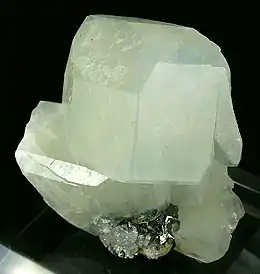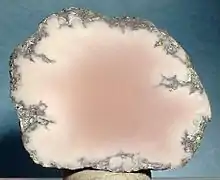Datolite
Datolite is a calcium boron hydroxide nesosilicate, CaBSiO4(OH). It was first observed by Jens Esmark in 1806, and named by him from δατεῖσθαι, "to divide," and λίθος, "stone," in allusion to the granular structure of the massive mineral.[5]
| Datolite | |
|---|---|
 Datolite on sphalerite from San Luis Potosí, Mexico (size: 6.2 x 5.3 x 2.8 cm) | |
| General | |
| Category | Nesosilicate |
| Formula (repeating unit) | CaBSiO4(OH) |
| IMA symbol | Dat[1] |
| Strunz classification | 9.AJ.20 |
| Crystal system | Monoclinic |
| Crystal class | Prismatic (2/m) (same H-M symbol) |
| Space group | P21/c |
| Unit cell | a = 9.62, b = 7.6 c = 4.84 [Å]; β = 90.15°; Z = 4 |
| Identification | |
| Color | Colorless or white; may be grayish, yellow, green, pale green, red, pink, etc. |
| Crystal habit | Crystal prismatic, short to tabular; Botryoidal or globular with columnar structure; granular to compact; cryptocrystalline |
| Cleavage | None |
| Fracture | Conchoidal to uneven |
| Tenacity | Brittle |
| Mohs scale hardness | 5 to 5.5 |
| Luster | Vitreous, rarely subresinous on fracture surface |
| Diaphaneity | Transparent to translucent, rarely opaque |
| Specific gravity | 2.96 – 3.00 |
| Optical properties | Biaxial (-) |
| Refractive index | nα = 1.626 nβ = 1.653 - 1.654 nγ = 1.670 |
| Birefringence | δ = 0.044 |
| 2V angle | Measured: 74° |
| Dispersion | r > v; weak |
| Ultraviolet fluorescence | Fluoresces blue under SW UV |
| References | [2][3][4] |
Datolite crystallizes in the monoclinic system forming prismatic crystals and nodular masses. The luster is vitreous and may be brown, yellow, light green or colorless. The Mohs hardness is 5.5 and the specific gravity is 2.8 - 3.0.

The type localities are in the diabases of the Connecticut River valley and Arendal, Aust-Agder, Norway. Associated minerals include prehnite, danburite, babingtonite, epidote, native copper, calcite, quartz and zeolites. It is common in the copper deposits of the Lake Superior region of Michigan. It occurs as a secondary mineral in mafic igneous rocks often filling vesicles along with zeolites in basalt. Unlike most localities throughout the world, the occurrence of datolite in the Lake Superior region is usually fine grained in texture and possesses colored banding. Much of the coloration is due to the inclusion of copper or associated minerals in progressive stages of hydrothermal precipitation.
Botryolite is a botryoidal form of datolite.
References
- Warr, L.N. (2021). "IMA–CNMNC approved mineral symbols". Mineralogical Magazine. 85 (3): 291–320. Bibcode:2021MinM...85..291W. doi:10.1180/mgm.2021.43. S2CID 235729616.
- Handbook of Mineralogy
- Mindat
- Webmineral
- One or more of the preceding sentences incorporates text from a publication now in the public domain: Chisholm, Hugh, ed. (1911). "Datolite". Encyclopædia Britannica. Vol. 7 (11th ed.). Cambridge University Press. p. 846.